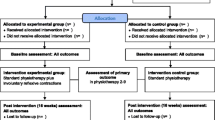Abstract
Ten women with urinary stress incontinence were treated with a new method of pelvic floor rehabilitation, using biofeedback training with a surface electrode inserted in the vagina and a catheter in the rectum. The effect of the training was determined by a pad-weighing test. The training taught the patients awareness of the pelvic floor muscles and how to avoid increases in abdominal pressure. Seven patients showed improved pad-weighing tests and 5 were fully continent after the training.
Similar content being viewed by others
References
Kegel AH. Progressive resistance exercises in the functional restoration of the perineal muscles. Am J Obstet Gynecol 1948; 56:238–248
Jacobsen H, Vedel P, Andersen JT. Objective assessment of urinary incontinence: an evaluation of three pad-different weighing tests. Neurourol Urodyn 1987; 6:325–330
Lose G, Andersen JT, Kristensen JK. Disposable vaginal surface electrode for urethral sphincter electromyography. Br J Urol 1987; 59:408–413
Abrams P, Blaivas JG, Stanton SL, Andersen JT. Standardization of terminology of lower urinary tract function. Neurourol Urodyn 1988; 7:403–427
Tchou DCH, Adams C, Varner RE, Denton B. Pelvic-floor musculature exercise in treatment of anatomical urinary stress incontinence. Phys Ther 1988; 68:652–655
Castleden CM, Duffin HM, Mitchell EP. The effect of physiotherapy on stress incontinence. Age Ageing 1984; 13:235–237
Henella SM, Kirwan P, Castleden CM, Hutchins CJ, Breeson AJ. The effect of pelvic floor exercises in the treatment of genuine urinary stress incontinence in women at two hospitals. Br J Obstet Gynaecol 1988; 95:602–606
Kujansuu E. The effect of pelvic floor exercises on urethral function in female stress urinary incontinence: a urodynamic study. Annals Chirurgiae et Gynaecologiae 1983; 72:28–32
Wilson PD, Alsamararai T, Deakin M, Kolbe E, Brown ADG. An objective assessment of physiotherapy for female genuine stress incontinence. Br J Obstet Gynaecol 1987; 94:575–582
Caufriez M, Wespes E, Schulman CC. Electrostimulation dans le traitment de l'incontinence urinarie chez la femme. Acta Urol Belg 1987; 55:397–400
Fall M, Ahlestrom K, Carlson C, Ek A, Erlandson B, Frankenberg S, Mattiasson A. Contelle: pelvic floor stimulator for female stress-urge incontinence Urology 1986; 27:282–287
Glen ES, Samuels BM, MacKenzie IM, Rowan D. Maximum perineal stimulation for urinary incontinence. Urol Int 1976; 31:134–136
Plevnik S, Janez J, Vrtacnik P, Trsinar B, Vodusek DB. Short-term electrical stimulation: home treatment for urinary incontinence. World J Urol 1986; 4:24–26
Peattie AB, Plevnik S, Stanton SL. Vaginal cones: a conservative method of treating genuine stress incontinence. Br J Obstet Gynaecol 1988; 95:1049–1053
Olton DS, Noonberg AR. Biofeedback. Clinical applications in behavioral medicine. Englewood Cliffs, New Jersey: Prentice Hall; 1980
Wear JB, Wear RB, Cleeland C. Biofeedback in urology using urodynamics: preliminary observations. J Urol 1979; 121:464–468
Gatchel RJ. Frequency of feedback and learned heart rate control. J Exp Psychol 1974; 103:274–283
Burgio KL, Whitehead WE, Engel BT. Urinary incontinence in the elderly. Bladder-sphincter biofeedback and toileting skills training. Ann Intern Med 1985; 104:507–515
Burgio KL, Robinson JC, Engel BT. The role of biofeedback in Kegel exercise training for stress urinary incontinence. Am J Obstet Gynecol 1986; 154:58–64
Author information
Authors and Affiliations
Rights and permissions
About this article
Cite this article
Glavind, K., Nøhr, S. & Walter, S. Pelvic floor training using biofeedback for muscle awareness in the treatment of stress urinary incontinence: Preliminary results. Int Urogynecol J 3, 288–291 (1992). https://doi.org/10.1007/BF00499645
Issue Date:
DOI: https://doi.org/10.1007/BF00499645




